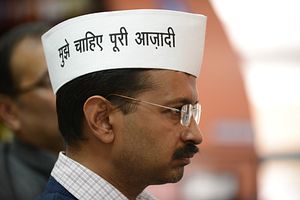On Saturday Arvind Kejriwal, the leader of the Aam Admi (Common Man) Party (AAP), was sworn into office as the new Chief Minister of Delhi. The rise of Kejriwal, a social activist who until a year ago was a relative unknown, has sent shockwaves through Indian politics. The Delhi elections were the AAP’s first electoral test, and the party’s spectacular performance at the ballot box has been heralded as a new phase in the country’s politics. But for observers of India, there is plenty about the AAP’s success that is familiar: populist policy promises, powerful anti-incumbency sentiments, and coalition building.
The AAP rode on the promise of combating corruption to oust Sheila Dixit, who had held the Delhi Assembly for the Congress for 15 years. The AAP were 8 seats short of a majority and, after an offer of “outside support” from Congress, took the Delhi Assembly with a minority government. The two parties were bitterly opposed before the election and new signs have emerged since then that suggest the union is likely to be fleeting one. The mixed signals issued by Congress leave open the possibility of them withdrawing support, whilst the AAP has pledged to take legal action against former (Congress) administrators accused of irregularities over the 2010 Commonwealth games.
The AAP’s experiment with forging alliances is one example of a wider governance phenomenon in India: coalition politics. Beyond Delhi, coalitions exist in a number of other states and, at the federal level, India has been governed by coalitions since 1989. Speaking to the Carnegie Endowment for International Peace, a Washington-based think tank, Christophe Jaffrelot, a renowned South Asianist, identified three factors that account for the emergence of coalitions in India: the demise of national parties, the emergence of regional parties and the increasing authority of states.
Since the 1990s no single party has won a majority in the national polls, a turning point that political scientists have dubbed the “post-Congress era” of Indian politics. The rise of regional parties – representing India’s diverse caste, class, and ethnic groups – has robbed the country’s biggest political formations, the Congress and BJP, of much of their support. Coalitions are the inevitable product of this new political settlement: as regional parties accrue more and more support, larger parties, with dwindling vote banks, are forced to form alliances to secure office.
Coalitions, of course, come with many challenges. The insecurity of coalitions was made clear last year when the Trinamool Congress, a junior coalition partner in the national government, withdrew its support over economic reforms. The defection threatened to tip the Congress-led UPA coalition into a minority, and only with the support of two other regional parties did the government survive. The UPA coalition, which has governed since 2004, has been hounded by allegations of corruption and maladministration. Manmohan Singh, India’s Prime Minister, has been accused by many of turning a blind eye to these transgressions over fears that coalition partners would desert his government if he took action. Because parties are unable to exploit parliamentary majorities to force through policies, a former Chief Justice of India condemned coalitions as a mark of the “degeneration of democracy”.
These disadvantages notwithstanding, coalitions provide ample cause for celebration. Gone are days of a single national party claiming to serve the interests and aspirations of India’s diverse groups. With a wider range of constituencies represented in office, coalitions represent a “deepening” and “widening” of India’s democracy. The Congress and BJP, unable to rely on previous stints in government to win votes, are forced to engage with voters alongside their competitors to regain support. And the presence of regional parties in government ensures that the interests of India’s states – which enjoy increasing political, economic and foreign policy clout – are reflected in national political agendas.
Waves of federalization, decentralization, and widening voter participation have made coalitions the hallmark of Indian politics. Parties now understand that brokering alliances with political rivals is as important as securing voter support. With political bargaining the key to securing office, many will be watching keenly to see how long the AAP and Congress remain bedfellows in Delhi. Similar questions are being asked of next year’s general election. The Congress party boasts decades of experience of courting political parties to form governments. If the BJP win next year’s election many are unsure if Narendra Modi – given his authoritarian tendencies – would be able to woo regional partners with similar success. Whatever the result, the politics and arithmetic of coalition building promise to be the story of Indian politics in 2014.

































